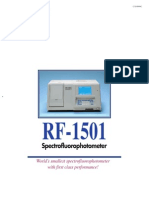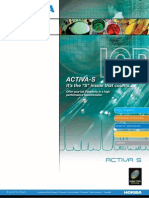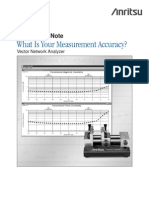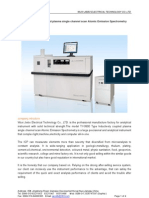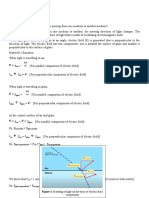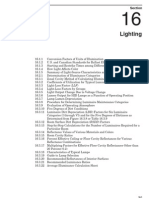U 1900
U 1900
Uploaded by
Abi Dzar Al-GhifaryCopyright:
Available Formats
U 1900
U 1900
Uploaded by
Abi Dzar Al-GhifaryOriginal Title
Copyright
Available Formats
Share this document
Did you find this document useful?
Is this content inappropriate?
Copyright:
Available Formats
U 1900
U 1900
Uploaded by
Abi Dzar Al-GhifaryCopyright:
Available Formats
Hitachi Ratio Beam
Spectrophotometer
1
U-1900
Model 101
Model 100
Model U-1000
Model U-1500
Model U-1800
Basic model configured by condensing a
great variety of measurement functions into
a compact and simple-to-operate design.
The spectrophotometer is indispensable for quantitative analysis in extensive fields including
biotechnology, new material development and quality control.
Therefore, its measurement accuracy, reliability and other basic performance factors must be absolute.
Hitachi Model U-1900 ratio beam spectrophotometer upgrades the basic performance, and also
simplifies the operating procedure.
Adoption of highly accurate ratio beam optics.
Standard incorporation of validation function
and self-diagnostic function.
A rich variety of functions such as DNA
quantitation, multi-point quantitation
and multi-wavelength measurement
are standard with this model.
Measurement conditions
can be saved.
Installation of the UV
Solutions program*
enables a personal
computer to control
this instrument.
*: Available at option
Measurement methods savable
A maximum of 5 measurement methods can be saved.
This ensures exact and easy re-measurement.
*: Because selection is allowed among plural methods, an analysts burden
can be reduced and necessary time can be shortened substantially.
2
Adoption of ratio beam optics
Ratio beam is a scheme in which part of the beam is branched with a half mirror
and its light quantity is detected with a detector to obtain a signal reference.
Thanks to the ratio beam scheme, an energy change in the light source, a tem-
poral change of optical elements, etc. can be compensated. Therefore, highly
stable photometric values are obtainable. This always ensures reliable results
even in long-time measurement.
Incorporation of stigmatic concave diffraction grating
The optics of this instrument adopts the Seya-Namioka monochromator wide-
spread as a representative concave diffraction grating monochromator.
Because a concave diffraction grating has both beam condensing and dispersing
functions, an optical system can be configured with fewer mirrors. In a spec-
trophotometer, use of fewer mirrors signifies a shorter optical path, thus giving
rise to an aberration-free bright optics.
For elimination of the aberrations which were essentially unavoidable in the past,
a stigmatic concave diffraction grating has been developed by applying Hitachis
original technology. As a result, a higher resolution has been realized.
Detector
Mirror
D2 lamp
WI lamp
Concave diffraction
grating
Entrance
slit
Exit slit
Filter
Mirror
Mirror
Half
mirror
Detector
Sample
Monochromator Sample
compartment
Lens
Large LCD and user-friendly keypad
Display characters are larger than those of the preceding instrument (U-1800).
Spectrum and working curve are easier to see.
In addition, a keypad featuring an easy-to-use key layout has been employed, so condi-
tion setting and measurement can be completed with the briefest possible key operation.
Personal computer-based instrument
control and data processing
High-level data processing can be carried out by controlling the Model
U-1900 from a PC when the optional UV Solutions program is installed.
Also, report generation will be supported through data pasting, transfer,
etc. to another application program.
For connection with a PC, an RS-232C communication cable is
required.
3 4
Basic performance of U-1900
Spectrophotometer U-1900 answering a broad range of measurement needs.
Measured data excellent in accuracy and reliability is assured by stable basic performance.
A large assortment of measurements selectable
including photometry and wavelength scan.
Diverse measurement techniques such as Photometry, Wavelength scan, Time scan, Ratio
Measurement and Multi-wavelength measurement can be used.
Superiority of ratio beam optics
Shown here is a difference in lamp stability
between single beam and ratio beam optics.
In single beam optics, absorbance signal
becomes unstable with the lapse of time. By
contrast, absorbance signal is stable for a
long time in the ratio beam optics where
change in the light source is compensated.
0.000
0.002
0.004
0.006
0.008
0.010
4,000 3,000 2,000 1,000 0 4,000
time (s)
Single beam Ratio beam
A
b
s
o
r
b
a
n
c
e
3,000 2,000 1,000 0
Main menu
Main menu contains the following items for selection of the
respective modes.
Photometry (sample concentration measurement)
Wavelength scan (spectrum measurement)
Time scan (measurement of change with time)
System (instruments self-diagnosis and environment setup)
Data display (expanded display in real time)
Photometry
Absorbance/transmittance measurement mode, ratio mode
and concentration measurement mode are selectable.
Concentration is measured by generating a working curve
from plural standard samples (max. 20 samples) or via fac-
tor input.
Wavelength scan
A spectrum resulting from scanning over a desired wave-
length range from 190 to 1,100nm can be displayed and fol-
lowed by qualitative analysis.
After measurement, peak search, smoothing and other data
processing can be effected.
Time scan
A spectrum can be displayed by scanning of photometric
value (absorbance/transmittance) at a fixed wavelength in a
desired measurement time from 60 to 99.999 sec.
After measurement, peak search, smoothing and other data
processing can be effected.
Data display
Effective for measuring absorbance or
transmittance at a single wavelength.
Wavelength value and measured data
can be displayed in large size.
Ratio calculation
Purity of nucleic acids can be deter-
mined by calculating the ratio at two
wavelengths (A260/A280).
Validation function
The following performance factors can be checked.
Wavelength accuracy
Wavelength setting repeatability
Bandpass
Baseline flatness
Baseline stability
Noise level
Great effect of 4 nm spectral bandpass
Benzene was measured as a sample at spectral bandpasses of
4nm and 5nm, and the respective spectra are compared here. It is
evident that the spectrum at 4nm bandpass is higher in resolution.
Notice the difference at 243nm. A peak was detected at 4nm band-
pass, while it was not detected at 5nm. Thus, a mere 1nm differ-
ence in spectral bandpass will affect analysis significantly.
Example of application
Quantitation of hexavalent chromium
An example of quantitative analysis of hexavalent chromium by
diphenylcarbazide absorptiometry is introduced here.
As a result of creating a working curve within 0 to 0.8g/mL, a corre-
lation coefficient of 0.9999 was obtained, proving an excellent cali-
bration relationship.
Measuring wavelength: 540nm
Concentration of standard solution: 0, 0.04, 0.1, 0.2, 0.5, 0.8g/mL
Reference: Raw data
Conc 0.0 0.04 0.1 0.2 0.5 0.8
Abs 0.000 0.031 0.081 0.162 0.408 0.646
a working curve
Correlation coefficient: 0.9999
5
Various options tailored for specific applica-
tions such as analysis for quality control.
UV Solutions program (P/N 2J1-0310)
The UV Solutions program enables a PC to control the U-1900.
When this program is installed, the following programs are usable.
(A Windows
XP compatible PC needs to be prepared separately.)
Option package program (P/N 2J1-0311)
Capable of performing color calculation and color difference calculation.
Nucleic acid measurement program (P/N 2J1-0316)
Usable for checking extraction and refinement of nucleic acids such as DNA/RNA essential for genetic research.
Data (photometric values at 230, 260 and 280nm), and calculation results (260/280, nucleic acid concentration, pro-
tein concentration, molar concentration) can be displayed collectively on the screen. This program is also intended
for labor saving in refinement work.
GLP/GMP program (P/N 2J1-0317)
The burden of optical instrument performance check can be alleviated.
Item-dependent measurement mode and automatic measurement mode (when no sample is necessary) have also
been prepared. In addition, a judgment tolerance range is settable so as to meet each analytical purpose.
Report generator program (P/N 2J1-0312)
Developed to enable freely customizing the report output format of measurement results. Microsoft
Excel is used for
report output.
UV Navigation program (P/N 2J1-0313)
This software supports automation of users analytical process ranging from measurement to data processing.
Report output to Microsoft
Excel is also supported and reports can be printed in various ways through combination
with the Report Generator.
Windows
XP and Microsoft
Excel are trademarks of Microsoft Corporation, U.S.A.
Microsoft
and Windows
are registered trademarks of U.S. Microsoft Corporation in USA
and other countries.
6
Auto sipper
(P/N 3J0-0100)
Effectively usable for quick analysis of multiple samples in
quality control and clinical chemistry. Sipping a sample
from sample tube automatically, this unit assists full
automation of absorbance measurement.
Specifications
Minimum sample volume 0.6mL
Carryover 1% or less
Cell capacity About 50mL
* This sipper is not capable of regulating cell temperature nor connecting
an autosampler.
Micro cell holder
(P/N 3J0-0102)
Specifications
Applicable cell 10mm rectangular cell
Temperature control By circulating water
* Circulating thermostatic oven and cell are not included in this product.
Communication cable
(P/N 121-1521)
Suitable for measurement of trace samples in medical and
biochemical fields.
Cells compatible with this holder are listed below.
Rectangular long path cell holder
(P/N 3J0-0105)
The optical path length of usable rectangular cell is 10, 20,
30, 40, 50 or 100mm.
This holder is mounted to a 4-cell changer for use.
The use of a long path cell is helpful for high-sensitivity
measurement of low-concentration samples.
Water circulated cell holder
(P/N 210-2111)
Water from an externally installed thermostatic oven is cir-
culated through this cell holder to maintain a rectangular cell
at a constant temperature.
A computer and the spectrophotometer main unit need to
be connected with this cable for computer control of mea-
surement using the UV Solutions program.
Specifications
Wavelength range 220 to 950nm
Cell mounting
/demounting repeatability
Within 0.3%T
Noise level Within 0.004Abs (50mL micro-volume cell used)
Cell
Specifications
Part No. Part name Capacity Optical path length
130-0622 50mL micro cell 50mL 10mm
130-0623 25mL micro cell 25mL 5mm
130-0621 5mL micro cell 5mL 0.5mm
NOTICE: For proper operation, follow the instruction manual when using the instrument.
Specifications in this catalog are subject to change with/or without notice, as Hitachi High-Technologies Corporation continues to develop the latest
technologies and products for our customers.
Tokyo, Japan
http://www.hitachi-hitec.com/science/
24-14 Nishi-Shimbashi 1-chome, Minato-ku, Tokyo, 105-8717, Japan
Tel: +81-3-3504-7211 Fax: +81-3-3504-7302
Printed in Japan (H) HTB-E035 2007.1
_ Ij 7
Printed with soy ink on 100% recycled paper.
Specifications Software functions
Optics Seya-Namioka mount monochromator, ratio beam
Wavelength range 190 to 1,100nm
Spectral bandpass 4nm
Stray light 0.05% or less (220nm for NaI, 340nm for NaNO2)
Wavelength accuracy 0.5nm (at 656.1, 486.0nm)
Wavelength setting repeatability 0.3nm
3 to 3Abs
Photometric range 0 to 300%T
Conc: 0.000 to 9.999
Photometric accuracy
0.002Abs (0 to 0.5Abs)
(certified according to 0.004Abs (0.5 to 1.0Abs)
NIST SRM 930)
0.3%T
Photometric repeatability
0.001Abs (0 to 0.5Abs)
(certified according to 0.002Abs (0.5 to 1.0Abs)
NIST SRM 930)
0.15%T
Wavelength scan speed 10, 100, 200, 400, 800, 1,200, 2,400, 3,600nm/min
Baseline stability 0.0004Abs/h (at 500nm)
Noise level 0.00015Abs (at 500nm)
Baseline flatness 0.002Abs (within 200 to 950nm)
Light source WI and D2 lamps
Light source changeover Auto (at 340.0nm)
Detector Silicon photodiode
Display LCD with backlight (12.2cm)
Printer I/F Centronics interface
Serial I/F RS-232C (exclusive for UV Solutions program)
Size (main unit) 380 (W) 643 (D) 311 (H) mm
Weight (main unit) About 27kg
Power supply 100, 115, 220, 230 or 240V, 50/60Hz
Power consumption 300VA
Measurement mode
Photometry
Wavelength scan
Time scan
Multiple-wavelength
Ratio (260/280)
Working curve type
Linear
K factor input
Calculation of correlation coefficient
Spectrum and working curve printout
Condition printout
Spectrum display
Peak/valley detection
Scale expansion/contraction
Smoothing
Validation function
Automatic wavelength calibration
Lamp ignition time
You might also like
- Manual RF-1501Document12 pagesManual RF-1501Dương Thùy25% (4)
- Optimus 50-65-80 SpecDocument6 pagesOptimus 50-65-80 SpecFarukhRabbaniNo ratings yet
- Catalogo U2900 PDFDocument7 pagesCatalogo U2900 PDFdernivaljrNo ratings yet
- U 2900 BrochureDocument7 pagesU 2900 Brochureaj747No ratings yet
- Uv2800 3800 4800Document12 pagesUv2800 3800 4800EdwardSamaelGNo ratings yet
- Product 7Document3 pagesProduct 7RobelNo ratings yet
- SpectroPhotoMeter - CatalogDocument7 pagesSpectroPhotoMeter - Catalogdéborah_rosalesNo ratings yet
- 2013 V600 Series BrochureDocument28 pages2013 V600 Series BrochureSteveihNo ratings yet
- AQ7270 Series: Optical Time Domain Refl EctometerDocument8 pagesAQ7270 Series: Optical Time Domain Refl EctometerSubrata MandalNo ratings yet
- UH5300Document16 pagesUH5300Merck Millipore Brasil - Lab Supply BrasilNo ratings yet
- UV/VIS Spectrophotometer: InstrumentsDocument11 pagesUV/VIS Spectrophotometer: InstrumentsMejdi GallNo ratings yet
- AAS 6200 ManualDocument12 pagesAAS 6200 ManualZulhasri WahapNo ratings yet
- Polarimeter MCP 300 - MCP 500Document8 pagesPolarimeter MCP 300 - MCP 500Ali RizviNo ratings yet
- Uv2800 3800 4800 PDFDocument12 pagesUv2800 3800 4800 PDFYessenia Siancas NietoNo ratings yet
- Shimadzu Uv 1700 Spectrophotometer Brochure PDFDocument24 pagesShimadzu Uv 1700 Spectrophotometer Brochure PDFGianCarlosQVNo ratings yet
- Horiba AP MonitorsDocument12 pagesHoriba AP MonitorssunitbhaumikNo ratings yet
- Ftir Spectrometers Ftir 4000 6000 SeriesDocument4 pagesFtir Spectrometers Ftir 4000 6000 SeriesMauricio CruzNo ratings yet
- 2100Q Sales TrainingDocument27 pages2100Q Sales TrainingHien NguyenNo ratings yet
- Multitype ICP Emission Spectrometer (ICPE-9000)Document16 pagesMultitype ICP Emission Spectrometer (ICPE-9000)mr_stali2987No ratings yet
- Xray ThermoDocument8 pagesXray ThermoIman Mahardika EgaNo ratings yet
- Automation of CO2 Laser Output Power Measurement As A Function of The Absorber Gas Pressureinacell Located Inside or Outside The Laser CavityDocument10 pagesAutomation of CO2 Laser Output Power Measurement As A Function of The Absorber Gas Pressureinacell Located Inside or Outside The Laser CavityNadia F Mohammad Al-RoshdeeNo ratings yet
- UV/VIS Spectrophotometer: Persee Analytics, IncDocument8 pagesUV/VIS Spectrophotometer: Persee Analytics, IncleslieNo ratings yet
- 7315 UVVisible Scanning SpectrophotometerDocument1 page7315 UVVisible Scanning SpectrophotometerLeonardo SalleNo ratings yet
- Agilent: 8990B Peak Power Analyzer and N1923A/N1924A Wideband Power SensorsDocument19 pagesAgilent: 8990B Peak Power Analyzer and N1923A/N1924A Wideband Power Sensorsleobiec1No ratings yet
- Cat OptoNCDT enDocument36 pagesCat OptoNCDT enNikhil SharmaNo ratings yet
- Activa S HoribaDocument8 pagesActiva S HoribaJhon Violeta MoreyraNo ratings yet
- C101 E130b PDFDocument24 pagesC101 E130b PDFHari YantoNo ratings yet
- F 7000 BrochureDocument7 pagesF 7000 BrochureMerck Millipore BrasilNo ratings yet
- AGC NovaSTREAM 6000 O2Document4 pagesAGC NovaSTREAM 6000 O2MiguelNo ratings yet
- Cellawire Pa 43: Pyrometer With Rectangular Field of ViewDocument12 pagesCellawire Pa 43: Pyrometer With Rectangular Field of ViewVanbeverNo ratings yet
- GCMS-qp2010 PlusDocument12 pagesGCMS-qp2010 PlusgangsNo ratings yet
- Spectro 2000 RS SpectrophotometerDocument4 pagesSpectro 2000 RS Spectrophotometerkkpig26No ratings yet
- Atomic Absorption Spectrophotometer: Printed in Japan 3655-01408-20AITDocument12 pagesAtomic Absorption Spectrophotometer: Printed in Japan 3655-01408-20AITAnonymous xCSrahNo ratings yet
- Spectrophotometer: Reliability & VarietyDocument19 pagesSpectrophotometer: Reliability & VarietyRonny BernardoNo ratings yet
- Shimadzu Uvmini-1240 and Biospec-Mini Uv/Visible Scanning SpectrophotometersDocument1 pageShimadzu Uvmini-1240 and Biospec-Mini Uv/Visible Scanning SpectrophotometersYehya EljoneidNo ratings yet
- Ficha Técnica Analizador de EspectroDocument8 pagesFicha Técnica Analizador de EspectroCarlitos Andrés Bravo UribeNo ratings yet
- DB 30Document2 pagesDB 30Ilias LikogiannisNo ratings yet
- Lachrom Elite: Hitachi High-Performance Liquid ChromatographDocument10 pagesLachrom Elite: Hitachi High-Performance Liquid ChromatographNaveen KamatNo ratings yet
- Surface TensionDocument25 pagesSurface TensionIshani Gupta100% (1)
- Turn-Key On-Line Analysis Systems Based On Spectroscopical Methods in The Near Infrared (NIR)Document14 pagesTurn-Key On-Line Analysis Systems Based On Spectroscopical Methods in The Near Infrared (NIR)Nicolae VisanNo ratings yet
- Gold Spectrumlab 54Document17 pagesGold Spectrumlab 54Korsarito100% (1)
- App Note 11410-00270Document8 pagesApp Note 11410-00270tony2x4No ratings yet
- For Isotropic Measurement of Magnetic and Electric Fields: Field Analyzers EFA-300Document10 pagesFor Isotropic Measurement of Magnetic and Electric Fields: Field Analyzers EFA-300CueindiazNo ratings yet
- MaestroNano MN-917 CatalogDocument3 pagesMaestroNano MN-917 CatalogvijayNo ratings yet
- Ty 9900Document4 pagesTy 9900Samir DarweshNo ratings yet
- Phosphate Ion Concentration MeterDocument4 pagesPhosphate Ion Concentration Metersaurabh_acmasNo ratings yet
- Libra Double BeamDocument8 pagesLibra Double Beampkuchonthara383No ratings yet
- Catalog High Voltage PDFDocument24 pagesCatalog High Voltage PDFاحمد عبدربهNo ratings yet
- Micro EpsilonDocument36 pagesMicro EpsilonOrnélio ClossNo ratings yet
- Recent Development in The Measurement Techniques: "Strain Gage As Usb Interface" Model 9205 Usb Interface SensorDocument11 pagesRecent Development in The Measurement Techniques: "Strain Gage As Usb Interface" Model 9205 Usb Interface SensorPruthvi CrazeNo ratings yet
- Aug 94 A 3Document9 pagesAug 94 A 3Norazimah Mat ZainNo ratings yet
- Opticline C200 C1000 EN 10026497 03 2009Document16 pagesOpticline C200 C1000 EN 10026497 03 2009Amit KumarNo ratings yet
- Aa6200 PDFDocument12 pagesAa6200 PDFCarlos CastroNo ratings yet
- H PLC Detector RangeDocument8 pagesH PLC Detector RangeVihangg MadaanayNo ratings yet
- Basic Calibration of UV/ Visible SpectrophotometerDocument5 pagesBasic Calibration of UV/ Visible SpectrophotometerMeta Zahro KurniaNo ratings yet
- Micro RulerDocument2 pagesMicro RulerFawwaz KhayyatNo ratings yet
- Handbook of Microwave Component Measurements: with Advanced VNA TechniquesFrom EverandHandbook of Microwave Component Measurements: with Advanced VNA TechniquesRating: 4 out of 5 stars4/5 (1)
- Note UNIT01-SF027 PDFDocument34 pagesNote UNIT01-SF027 PDFBerry101No ratings yet
- MTech Optoeletro and Optical CommDocument3 pagesMTech Optoeletro and Optical CommNiteshNo ratings yet
- CANON PowerShot G11 - Service ManualDocument91 pagesCANON PowerShot G11 - Service Manual1222112No ratings yet
- PhysicsDocument28 pagesPhysicsamritam yadavNo ratings yet
- Q1 Science Reviewer g10Document3 pagesQ1 Science Reviewer g10Rianne MoralesNo ratings yet
- Imec HSI TechnologyDocument40 pagesImec HSI TechnologySuresh SkvNo ratings yet
- 40 Meter AddOn Kit Hexbeam EnglishDocument7 pages40 Meter AddOn Kit Hexbeam EnglishCPC PHCNo ratings yet
- A Microwave Welding Process: An OverviewDocument5 pagesA Microwave Welding Process: An OverviewTanuj Singh Chauhan100% (1)
- LU 1 Digital Image Receptors 2022 Part 1Document42 pagesLU 1 Digital Image Receptors 2022 Part 1kgalalelounisaNo ratings yet
- The Enormous Letter eDocument4 pagesThe Enormous Letter eapi-206391548No ratings yet
- Journal of Refractive Surgery DECEMBER 2023Document93 pagesJournal of Refractive Surgery DECEMBER 2023aleksandrastartseva25No ratings yet
- Document PDFDocument2 pagesDocument PDFFranceslNo ratings yet
- Design of H-Plane Sectoral Horn Antenna For Microwave Applications Using MatlabDocument9 pagesDesign of H-Plane Sectoral Horn Antenna For Microwave Applications Using MatlabvardhanNo ratings yet
- Radiology Sample PDFDocument5 pagesRadiology Sample PDFmedpgnotesNo ratings yet
- 007 Transmission Media (CH 07)Document49 pages007 Transmission Media (CH 07)Awais OemNo ratings yet
- Correlation Between Gravitational and Inertial Mass - Theory and Experimental TestDocument7 pagesCorrelation Between Gravitational and Inertial Mass - Theory and Experimental TestCharles OstlerNo ratings yet
- Kre1012653 - 1 - Odi2-065r15m18j02-Q V3Document3 pagesKre1012653 - 1 - Odi2-065r15m18j02-Q V3Talha JavedNo ratings yet
- Advantages and Disadvantages of Space TelescopeDocument4 pagesAdvantages and Disadvantages of Space TelescopeNandanNo ratings yet
- Surface Temperature: C T 0 A MaxDocument2 pagesSurface Temperature: C T 0 A MaxjameeloNo ratings yet
- Laser DiffractionDocument2 pagesLaser DiffractionthrockmiNo ratings yet
- BL Lighting Catalogue 2016Document121 pagesBL Lighting Catalogue 2016Federico Pérez de LeónNo ratings yet
- Which Are The Types of Antennas Used in Satellite Communication Write in Detail.Document5 pagesWhich Are The Types of Antennas Used in Satellite Communication Write in Detail.Sahithi ParuchuriNo ratings yet
- Decreasing Wavelength Increasing Increasing Frequency Decreasing Increasing Energy DecreasingDocument4 pagesDecreasing Wavelength Increasing Increasing Frequency Decreasing Increasing Energy DecreasingKyla Estrella de VeraNo ratings yet
- RefractionDocument15 pagesRefractionIli AtallaNo ratings yet
- EC2402 - OCN Two Marks Questions and AnswersDocument37 pagesEC2402 - OCN Two Marks Questions and AnswersshanmugachitraNo ratings yet
- Question: Why Light Is Bend While Passing From One Medium To Another Medium? Answer: When Light Passes From One Medium To Another, The Moving Direction of Light Changes. TheDocument2 pagesQuestion: Why Light Is Bend While Passing From One Medium To Another Medium? Answer: When Light Passes From One Medium To Another, The Moving Direction of Light Changes. Theshouvik100% (1)
- LED: An IntroductionDocument13 pagesLED: An IntroductionshipraformalNo ratings yet
- LightingDocument36 pagesLightingdaodoquang100% (1)
- TUt Soln MergedDocument16 pagesTUt Soln MergedRISHITA SINGH 18102047No ratings yet
